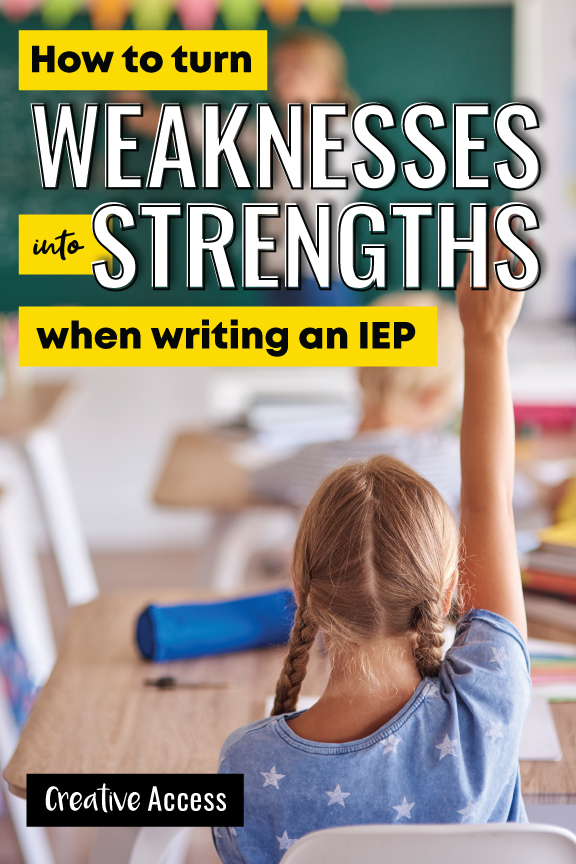One of the first pages in an IEP is the Present Levels of Academic Achievement and Functional Performance page (often abbreviated as PLAAFP, PLOP, or PLP). Special education teachers disagree on best practices in the PLAAFP: some think the page should be strictly data-driven, while some teachers prefer to include some anecdotal information as well.
I always include data, such as assessment scores and progress monitoring data, but I think there’s a lot of value in including qualitative information about a student’s personality and interests as well. It helps teachers and future case managers understand some of the student’s personal qualities, not just their test scores and deficits.

The first box on the PLAAFP page asks case managers to document a student’s strengths. I typically include strengths like motivated, caring, independent, athletic, artistic, a strong writer, or any other academic or functional skills at which a student excels.
Every once in a while, I have a student who really struggles academically and functionally (and usually behaviorally), and I have a difficult time filling out the strengths section. However, I am a firm believer that every student deserves the dignity and pride of having a full strengths section, because every student has strengths — even if they’re hard to find.

Below, I share some of the most common “negatives” I see in students, and how I rephrase them to be “positives.”
| Before | After |
| Michael is hyperactive. | Michael is energetic. He enjoys taking movement breaks by walking at the back of the classroom. |
| Elena talks too much in class. | Elena has many friends in class and enjoys being social. |
| Colton gives up too quickly. | Colton is learning how to persevere through difficult tasks. |
| Kyah is four grade levels behind in math. | Kyah’s test scores show she is performing at a grade equivalent of 2.6. She has made great improvements in math over the past year (be specific). Getting support in the resource room has been very helpful for her. |
| Isaac is rude to his classmates and teachers. | In small-group social skills lessons, Isaac is able to show appropriate behavior in 85% of sessions. He is still working on displaying these skills appropriately in class. |
| Adalynn rushes through her work. | Adalynn is highly motivated to get work done quickly. She benefits from reminders to slow down. |
| Luca constantly taps his pencil in class, which annoys his classmates. | Since implementing Luca’s behavior plan, he has done a great job choosing a quiet fidget toy. |
| Isatou is uninterested in school and difficult to motivate. She refuses to do the work for most of her classes. | Isatou is interested in sports and art club. She is motivated to participate in basketball, so Mr. Collins recommends that Isatou stay for after-school tutoring to bring her grades up. This will help make sure she is eligible to play sports. |
| Travis does not ask for help in class, even when he really needs it. | Travis accepts help when it is offered. He is comfortable asking a peer for help. His self-advocacy goal will address strategies to ask a teacher for help. |
| Sarah is easily distracted during whole-class instruction. | Sarah loves looking out the window and watching the students on the playground during whole-class instruction. (You can address this concern outside of the strengths section.) She is very attentive during small-group and one-on-one lessons. |
| Juan spends too much time playing games on his iPad. He constantly has to be reminded to put it away. | Juan is highly motivated by his iPad games. Perhaps we should consider using iPad games as a reward. |
| Layla is antisocial. She does not like working with other students. | Layla does best working alone on assignments. Recently, she has chosen a few trusted peers she can work with when group work is required. |
| Nathan blurts out answers during class discussion. | Nathan is confident in his answers and excited to participate in class. |
| Nadia is nonverbal. | Nadia uses facial expressions and picture symbols to communicate. |
| Brody doesn’t follow directions. | Brody does best when directions are presented in multiple ways, including written and visual. |

In the above examples, I use several strategies to pull strengths out of weaknesses. Chances are, there are some positives hidden in those challenges the student experiences. Here are some of the strategies:
- Change your vocabulary. Replace negative-connotation words like hyperactive with positive-connotation words like energetic. They mean almost the same thing, but only one is perceived as a problem.
- Bring in additional information. They’re not interested in math? Okay — what are they interested in?
- Add needs statements. Not everything is positive all the time. Our students do have needs that must be addressed. So, start with a strength. Then, talk about what the student needs.
- Discuss how the issue has been or will be addressed. Are you putting a behavior plan in place? How is the student doing with a replacement behavior? Did you propose a new goal or accommodation?

Looking to incorporate more strengths-based language in your next IEP or 504?
The Student Strengths Rating Scale is a survey tool to gather information about a student prior to a special education evaluation, IEP meeting, 504 meeting, or other problem-solving meeting. It shows case managers or other professionals where the student’s strengths lie and which areas may require support or accommodations, from the perspective of both professionals and the student. Grab yours here.
Want to be notified every time I publish a new blog post? Leave your email address below.

